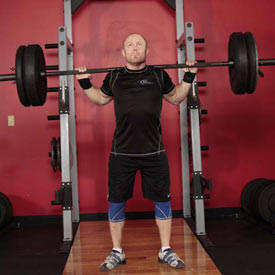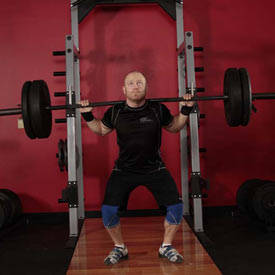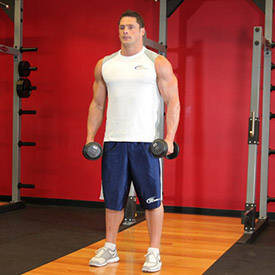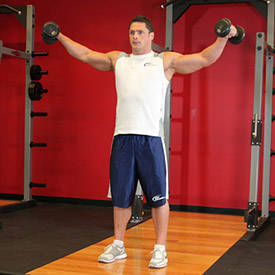One of the most famous sayings in bodybuilding is "Shoulders make the man". Any bodybuilder, in reasonably good shape under the stress of a load, ought to be able to show striations in the three deltoid heads. Take a look at these marvelous shoulders. Now Roland Kickinger is under a different stress load here. Yes, it takes a broad-shouldered man to handle these sexy broads. With these two babes hanging over your shoulders, anyone could get a good pump.
Besides his calves, forearms, never self-effacing ego, and his sometimes situational-stubborn male sexual organ, nothing is harder for a man to enlarge than his deltoids.
You wanna know why? Of course you do. Muscles that we have used for work, over the eons of passed time simply do not respond well to exercise, being geared primarily for endurance rather than power. It's as if these recalcitrant muscles simply say, "Screw you buddy, been there, done that." Consider that our sternocleidomastoides (which is to say side neck muscles) work some 16 hours a day supporting and turning our clunky 30 lb. heads. Also our calves become thick and dense and used to work, keeping us upright and powering us around all day long.
Our forearms are really a network of what seems to be a zillion multi-functioning fibrous workhorses, capable of effecting ambidextrous digitation, multiple wrist, hand, finger and elbow motions. Likewise, our deltoids work every time we move our arms or do something over head or at shoulder height (and believe us now and hear us later) as Hans and Franz used to exclaim, there are lots and lots of these motions over a 24-hour period.
Now consider your pectoralis major and minor. These muscles never do much of anything except sit. So like your thighs once you start to squat, when we start to do bench presses, voila' look out - your pectorals grow like Bill Phillip's EAS bank account. (Well, maybe not quite that much.) Nonetheless, The PM growth squadron is never surprised when bodybuilders lament that they can't get their deltoids up to snuff.
Stud Shoulders For Everyone?
"One man's meat, another man's poison." Ever heard that one? People are never built the same, with many variations in structure, leverage, muscle fiber types and amount. Thus, we all respond somewhat differently to the same bout and type of exercise. To make matters more confusing, we even have different growth-rate responses among varying muscle groups within our own bodies, let alone in comparison to Manny, Moe or Jack.
One bodybuilder can do the standard bench press and see his pectorals grow to Oliva and Schwarzenegger proportions, but yet, despite working very hard, when he does calf raises, all he gets is Pee-Wee Herman calves.
Then there is the injury problem. Some patrons of pump, especially those with long torsos, just cannot hack exercises such as squats and deadlifts. Others cannot do behind-the-neck presses, dips or lat machine pull-downs because of shoulder impingement, cuff or capsular problems, and a few cannot do inclines and/or bench presses for many of the same reasons. Every bodybuilder must discover his own meat or poison, as it were.
Genetic and unique body response is one thing but, oft times, a lagging body area sucks because you are not training it properly. Relative muscle isolation and technique quirks are not something to dismiss. Many times, bodybuilders, brainwashed by the bigger boy workouts (those guys who are on so much protein and steroids, that sending it all south of the border backwards, would mean that all the people of Mexico City could be fed well), try to train too heavy and miss the nuance of muscle pump through isolation.
What happens? Simply put, you do not develop the kinesthetic proprioception, or response and feel, for the muscle group that you are trying to isolate and work. Because your training weight is too heavy, you enlist secondary muscle groups (synergy overload) to lift the weight. In effect, as a true bodybuilder sees it, you're a cheating bastard.
Let's say you are doing dumbbell laterals. You should lift the dumbbells upward slowly, with your little finger higher than your thumb (pouring the spout) and lift primarily with the power of your medial deltoid head.
But hey, not you. Instead, in a lame egoistic effort to use 55 lbs. instead of 35 lbs., you start by leaning way forward using back extension (along with turning the dumbbells into an external rotation position) to gain momentum to assist and swing up the weights.
Don't kid yourself, buddy. This relative external rotation brings the stronger anterior deltoids more into play. Together your anterior deltoids and low back extensor swing action make this exercise movement hardly as pure as any driven snow.
Initial neural impulse and momentum should never do the lifting unless you are going for a one-rep maximum effort. Considering the would-be bodybuilder's dress code today too (meaning - don't expect to build maximum muscle without maximum visual and sensory feedback). Another reason people fail to grow dynamite delts is that they use the same exercises all the time, use the same techniques and always do the same number of sets and reps.
As we mentioned in another article last issue, these automatons stick to the same range of motion and the same training principles (or lack thereof) all the time. Their muscles soon adapt to the regularity of the training sessions and have no stimulus for growth.
In bodybuilding, change is not something to fear. Changing to a higher order of technique nuance is what keeps muscle growing.
If you want a pair of Studley-Do-Right deltoids, forget all the fancy junk and really work hard on this BIG-2 routine. We know that your deltoids will be much bigger and stronger because of it.
EXERCISE 1 Push Press - Behind the Neck
1 set of 16-20 reps, 1 set of 10-13 reps, 3 sets of 6-9 reps, and 1 set of 12-16 reps


Push Press - Behind the Neck (Shown standing)
Lately, a few so-called certified trainers have given this exercise a bum rap. These are those freshly graduated, correspondence-course, all-knowing sages, as it were. Of course, no matter that Chuck Sipes, Bill Pearl, Reginald Park and Marvin Eder developed the strongest deltoids in natural training history just by doing behind-the-neck presses, the granddaddy of deltoid exercises. Once more, none on them developed debilitating shoulder dysfunction, as has been so tiresomely predicted.
For an entire era previous to Ronnie Coleman's out-of-this-galaxy musculature, behind-the-neck presses were to the 'man' as bench presses are today.
Critics of the BNP argue it causes too much shoulder strain and impingement of the shoulder, but these problems generally affect athletes with pre-existing pathology, who also have trained relentlessly with the heaviest weights for many years, with sloppy, drop-it-on-your-atlas-vertebrae technique. Although you can do behind-the-neck presses standing or seated, we definitely think the seated version is safer with less stress on the lower back, and just perhaps, might allow you to isolate your medial deltoids better. The behind-the-neck press is a great compound movement that affects your traps, triceps and upper pectorals too.
BNP Exercise Styles
There is more than one way to skin a cat, or press a barbell. In an Olympic lifting style press, your hands are closer together and you press fast with "your elbows under". You have a natural back bend and lock out at the top. This style is a quick lift where you can move a lot of weight. It is questionable how much work your deltoids actually get. Don't press anything Olympic style (not even ham). This is no "military" press like the days when 200 lb. John Grimek did 370 lbs. before steroids.
The second method of pressing is a bodybuilding or military press. Look in any magazine at a bodybuilder doing behind-the-neck presses and you immediately notice the grip is medium-to-wide, never narrow. A wide grip forces the elbows wide and to the side, not in front of the deltoids as in Olympic-style pressing. This technique places more overload on the deltoids, and perhaps, more on the medial head of the deltoid.
When you press, you should not lock out either. This technique places more tension on your entire deltoid with perhaps some extra stress on your medial heads. Don't let em' relax!
If you do them seated, you won't lean back too far and cheat by using secondary muscle groups. You cannot "kick" with your legs or use leverage positions by leaning back. The BNP is a compound, two-joint movement, so it should be your heavy exercise of the routine. Likewise, don't scrunch down and lean back against a bench set at mid back height because then you turn this exercise into a high incline press and the work is shared by your upper pectorals and front deltoids much more than the whole deltoid.
At any rate, after a couple of light warm-up sets, don't be afraid to pile on the plates and go for some heavy lifting. Your work sets (to a point on each set of failure positively) should be these sets and reps and don't be afraid of the higher reps as blood makes more than the grass grow. All sets are to failure within the prescribed rep range.
EXERCISE 2 Dumbbell Laterals
1 set of 20-25 reps to failure, 1 set of 12-16 reps to failure, 3-4 sets of 8-12 reps to failure


This is the numero uno exercise to develop your medial deltoid heads. We again suggest doing them while seated. Isolating the medial head of the deltoids is easier said than done because secondary muscle groups too readily come into play. So, don't kick with your legs, swing with your arms, shrug with your delts and traps, or lean forward to start, or backwards to finish.
Your hands should hold the handles with an overhand grip (thumbless, if possible). If you have very small hands you might not be able to do laterals without wrapping your thumbs around the handles. You might hold the dumbbells very slightly off center. Notice Cory Everson's perfect style in the vintage shot at the left, but then again, she had the best coach who ever lived.
This off-center nuance gives you a head start on the "pouring the spout" effect you want at the top of the movement. Remember, it is better anatomically to be in slight internal rotation with abduction versus external rotation, since your anterior deltoids are so much stronger than the other two heads. At the beginning of each repetition hold the bells in front of your body at upper thigh level. Your palms should face each other with the outer plates of each dumbbell touching. Lock your wrists and bend your elbows slightly by splaying them to the sides.
Your hands should be in a swan-dive position in front of your body, not resting against your sides. Ensure that your elbows are in line with your shoulders. You do not want to lift the dumbbells with your hands leading. Instead, lift your elbows in line with your shoulders and lead with your elbows not your hands.
So, as you begin each rep from the bottom, you make a conscious effort to raise your elbows of each arm higher than your wrists. Turn your hands in slightly - like pouring a spout or pitcher of water - but make the turning subtle. The key is to raise your elbows as high as shoulder level (or just slightly higher if possible) and to feel the side heads working. (Don't go all the way to the top with your dumbbells as then you bring in way too many trapezes muscle.)
Your hands are always "just hooks" holding onto the bars. The position of your elbows and the raising of them up to and past shoulder level forces your side, or medial deltoids, to work very hard. Don't lean back at the top as you finish each rep. Keep your elbows in line with your shoulders and the palms of your hands in front of your body. Your palms should always face down. (Occasionally, you can do your dumbbell laterals first or superset laterals and BNP's.)
You can also do drop sets with dumbbell laterals. (Start with your max for 10-15 reps to failure, set those down, grab weights that are 10 lbs. less and do the same with those, then set those down, grab another 5-10 lb. less weight, and go to failure at 15-20 reps.) In general, here is what we like for dumbbell laterals:
Conclusion
Yes, deltoids can be a real nuisance body part. They are thick, three-headed fire-breathing Hydras used to a lot of work and are stubborn like a female mule in estrus. To get your deltoids to grow, never train them more than twice in any 8-10 day period, especially if you do not use steroids. And don't get too fancy-smancy or attempt to use weights that are too heavy in an exercise where your leverage is poor, like the lateral raise exercise. Save the big stuff for the BNP.
Work for the flush, the pump and burn. Don't think you have to lift the Louis Cyr 220 lb. dumbbell. Leave that folderol for Bill Kazmaier and other strength Gods of the flesh. Instead, try this simple, 2-part, direct deltoid BLAST approach. Soon enough your deltoids will be bigger, stronger and thicker. You know why? Of course you do, because PLANET MUSCLE gives good deltoid.
